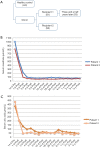Donor-derived hypouricemia in irrelevant recipients caused by kidney transplantation
- PMID: 32355774
- PMCID: PMC7186701
- DOI: 10.21037/atm.2020.02.140
Donor-derived hypouricemia in irrelevant recipients caused by kidney transplantation
Abstract
Background: Hereditary renal hypouricemia (HRH) is a genetically heterogenetic disease. Patients with HRH are almost asymptomatic; but some may experience exercise-induced acute kidney injury (EAKI) and nephrolithiasis which may bring concerns regarding the risk-benefit ratio as marginal kidney donors. This study examined the pathogenic mutations of hypouricemia in two recipients after receiving kidney transplantation, providing preliminary evidence for the mechanism of hypouricemia.
Methods: Two participants underwent detailed biochemical examinations. DNA and RNA were extracted from transplant specimens for sequencing. The whole-genome sequencing and polymerase chain reaction (PCR) amplification were performed to confirm the pathogenic genes. Functional effects of mutant proteins were verified by bioinformatics analysis. RNA-sequencing (RNA-seq) was used to study the transcriptome of hypouricemia.
Results: Both of the recipients had the low serum uric acid (UA) (45-65 µmol/l), high fraction excretion of UA (44% and 75%) and an increase in the UA clearance (35.9 and 73.3 mL/min) with a functioning graft. The sequencing analyses revealed 7 kinds of potential mutational genes in this case, two novel mutations p.R89H and p.L181V in SLC22A12 gene which were revealed by bioinformatics could be pathogenic in nature.
Conclusions: Two novel mutations of SLC22A12 were identified. Preliminary functional analysis revealed a potential deleterious effect of these mutations in the grafts derived from the donor and sequencing analysis expand the molecular mechanisms of renal hypouricemia.
Keywords: Hereditary renal hypouricemia (HRH); SLC22A12; kidney transplantation; single nucleotide polymorphism (SNP).
2020 Annals of Translational Medicine. All rights reserved.
Conflict of interest statement
Conflicts of Interest: The authors have no conflicts of interest to declare.
Figures



References
LinkOut - more resources
Full Text Sources
